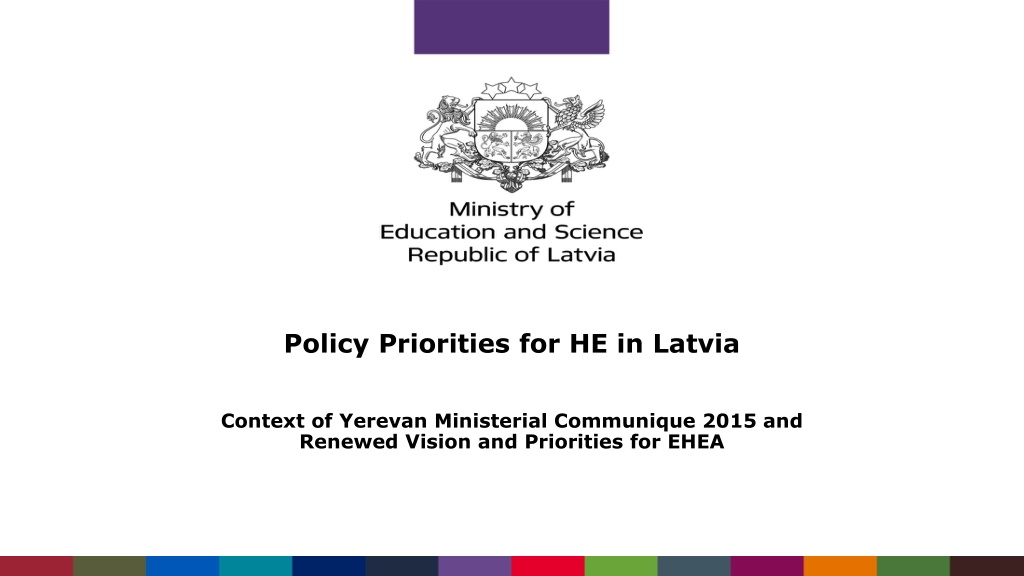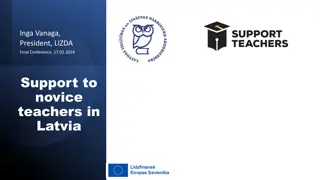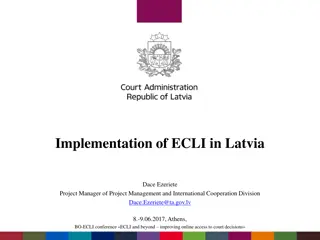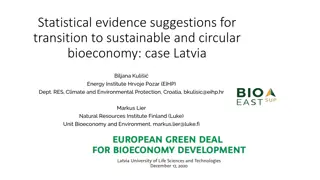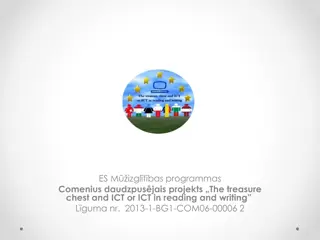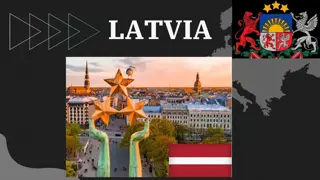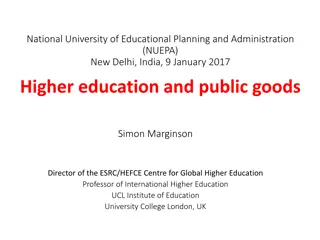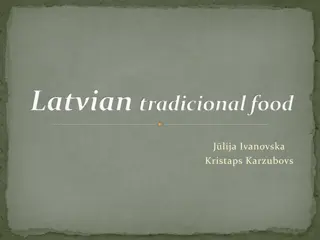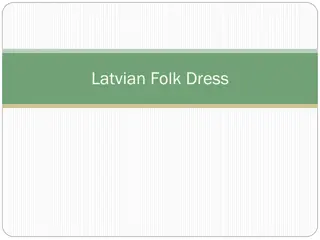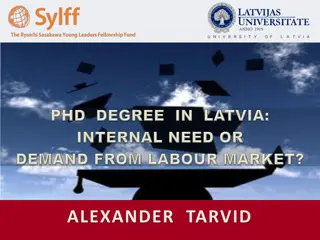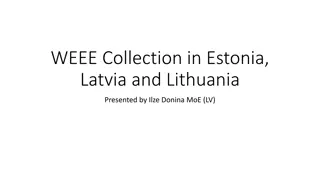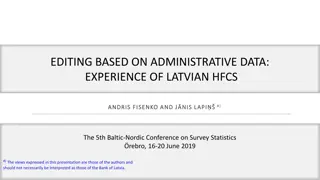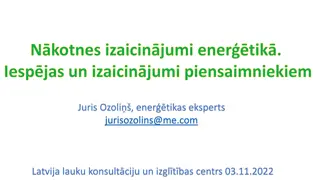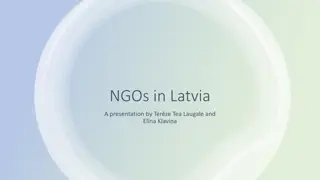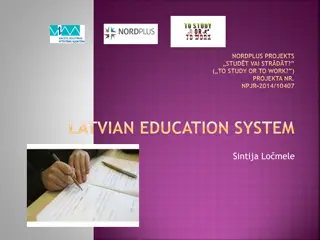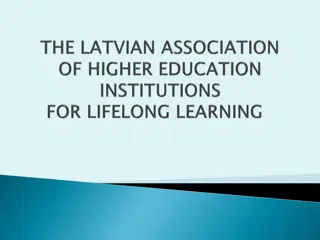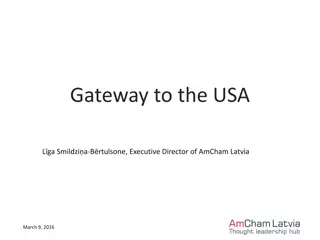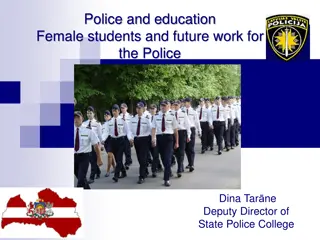Priorities for Higher Education in Latvia: Context and Framework
Emphasizing quality teaching, graduate employability, inclusivity, and structural reforms, Latvia's higher education system focuses on diverse knowledge bases, human capital in science and technology, and supportive infrastructure. The R&D&I system framework and core actors play crucial roles in shaping Latvia's education and innovation landscape.
Download Presentation

Please find below an Image/Link to download the presentation.
The content on the website is provided AS IS for your information and personal use only. It may not be sold, licensed, or shared on other websites without obtaining consent from the author. Download presentation by click this link. If you encounter any issues during the download, it is possible that the publisher has removed the file from their server.
E N D
Presentation Transcript
Policy Priorities for HE in Latvia Context of Yerevan Ministerial Communique 2015 and Renewed Vision and Priorities for EHEA
Priorities Yerevan Ministerial Communique Enhancing the quality and relevance of learning and teaching; Fostering the employability of graduates throughout their working lives; Making the systems more inclusive; Implementing agreed structural reforms.
Context of HE in Latvia: Public investment in knowledge base, S&T human capital and infrastructure for economic development Knowledge base Sufficiently diverse (to serve five specialization areas) Focused and relevant (to ensure competitiveness) S&T human capital Locally embedded (to develop local industry) Globally connected (to reach out for opportunities) Links across sectors and disciplines (to benefit from cross-fertilization) Infrastructure Serves creation of knowledge base and human capital Allows production of relevant knowledge Jointly used sectorally, nationally and internationally Supports conversion of tacit knowledge into innovation 3
The Latvian R&D&I System Framework conditions Financial environment, tax regime, Demand Consumers (final demand) Producers (interim demand) entrepreneurship and innovation incentives, regulatory environment, State aid, mobility Industry system (R&D FTE 981) System of Education and Science (R&D FTE 4415) Political system Traditional economic sectors The Saeima, Cabinet of Ministers Research institutes, National Research Centers Higher education and research MoES, MoE, line ministries and gov., agencies Competence Centers Future growth sectors with high added value Studies commissioned by the Public sector R&D&I and Industrial policy, RIS3 Technology transfer structures Vocational education and training Sectors with high horizontal impact Infrastructure Standards and requirements Banks, venture capital R&D&I and business support instruments Research infrastructure Information 4 Adopted from Erik Arnold and Stefan Kuhlman, RCN in the Norwegian Research and Innovation System, Background Report No 12 in the Evaluation of the Research Council of Norway, Oslo: Royal Norwegian Ministry for Education, Research and Church Affairs, 2001
Roles of core actors Latvian HE&R&I System Facts: Public investment in research in Universities leads to: Economic growth through an increase in private sector productivity; Beneficial economic and societal impacts through increased interaction between the academic and private sectors; Public investment in research increases rather than diminishes private sector investment (complementarity). Role of INDUSTRY to innovate (demand side) Role of UNIVERSITIES Knowledge Hubs: to develop sufficiently diverse knowledge base (supply side) to boost innovation capacity of firms through provision of human capital and access to knowledge (demand side) to generate S&T human capital that is sufficiently embedded and connected (absorptive capacity) to pool resources across sectors and regions (innovation ecosystem). Role of RESEARCH INSTITUTES - to develop relevant knowledge (supply side) Role of GOVERNMENT Enabler to set structure of incentives, correct market and policy failures 5
YMC Priorities and HE quality, relevance and allignemnt with goals of economic development Consolidation & integration Accessibility and participation YMC Priority: Implementing agreed structural reforms YMC Priority: Fostering the employability of graduates; Infrastructure and knowledge base: ERDF infrastructure projects; Consolidation projects; Study and research environment. Students and graduates: Loans and stipends; Tuition fees; Full-time/part-time studies. Students Resources Quality & Relevance Effectiveness & cost efficiency YMC Priority: Enhancing the quality and relevance of learning and teaching Framework and incentives YMC Priority: Making systems more inclusive. Teaching staff Academic and scientific personnel: Selection procedures; Mobility; Raising qualification. External and internal regulations: Funding model; Revised regulation for quality assurance. 6
New HE&R Funding Model Basic funding corresponding to strategy and labour market forecasts Performance based funding for HE&R integration Funding for development in line with priorities Priority for 1st pillar funding: Strategic specialization and relevance to economic development; Integration of research and teaching funding. pillar 2: performance oriented funding pillar 3: innovation oriented funding pillar 1: basic funding teaching numbers of study places (per field) ERAF: Post-doc 64 MEUR Applied research 76 MEUR Innovation grants 34 MEUR 5,5 MEUR 2015 6,5 MEUR 2016 6,5 MEUR - 2017 cost oriented weight 85 MEUR 2015, 2016 un 2017 profile-oriented target agreements teaching + research + third mission Research staff FTE (MAs, PhDs) Priority for 2nd pillar funding: Integration of HE and research. numbers of research staff (per field) research funding of centers of excellence Industry funded research; cost-oriented weight 22 MEUR 2015 27 MEUR 2016 27 MEUR - 2017 International research.
Reallocation of study places & monitoring of graduates Contracts with HE institutions: MoE is negotiating and concluding the annual contracts with HEIs on the number of students and graduates produced , gradually reallocating state subsidized study places for STEM studies Total funding for state subsidized study places in 2016 85 MEUR. Register of Students: The State Education Information System is being extended to include the students roll-out in 2016; The goal for 2017 is to connect the System with the Data base of the State Revenue Service and the State Employment Agency to monitor the success of graduates on the job market (employment and income) and thus analyze the State s return on the state subsidized study places by programmes, institutions etc.
Performance based funding of HEIs (2nd pillar) Performance criteria according to policy priorities: Building HRs in research and technology development MA students, PhD students, new scientists engaged in research - (0.3) International competitiveness of research International funding for research and development projects (Horizon 2020 etc.) - (0,25) Industry relevance of research Public funding, contract funding by commercial entities (0.25) Funding by local governments for regional research projects - (0.1.) Funding for creative and artistic projects - (0.1)
Support for Accreditaion capacity building New accrediation regulation: Professionalization, recomendations and quality monitoring, competitive costing, lean operation, international accreditation. Timeline for accreditation capacity building 6 Nov, 2015 AIC has submitted project application (8.2.4. SO To provide support for implementation of requirements of EQAR agency " this will contribute to the capacity development of the AIC; total funding 1.5 MEUR); End of Nov, 2015 Decision on project approval; Jan/ Feb, 2016 starting the project (2016-2019) 31 Dec, 2017 submitting compliance assessment (with the ESG) application; 31 Oct, 2018 - submitting an application for accreditation and registering AIC into the EQAR; Beginning of 2019 Decision on the fulfillment of conditions.
HORIZON 2020 Participation in the EU research and technology development programmes (2014 2017) 5.72 million euro (MoES, NB) Corporate income tax allowances for stimulating production when purchasing new production equipment Corporate income tax allowances for research and development costs FLP (2014 2017) 20.76 million EUR (IZM, SB) Technology transfer programme 24.5 million euro (MoE, SF) Reuse of public data 151.54 million euro (MoEPRD, SF) Public infrastructure facilitating business in regions 114.2 million euro (MoEPRD, SF) Facilitating access to funding 51 million euro (MoE, SF) NRP (2014 2017) 26.96 million EUR. (IZM, SB) Support for small and medium- sized enterprises for the development of new products and technologies 7 million euro (MoE, SF) Science base funding (2014 2017) 99.16 million euro (MoES, NB) Training of the unemployed 24.90 million euro (MoE, SF) High-growth enterprises 75 million euro (MoE, SF) Support for the creation of production infrastructure and purchasing equipment 81.75 million euro (MoE, SF) Territory revitalization 278.26 million euro (MoEPRD, SF) Practically oriented research 76.51 million euro (MoES, SF) Training the unemployed according to the labour market demand 96.4 million euro (MoW, SF) Competence centres 72.3 million euro (MoE, SF) Innovation grants to students 34 million euro (MoES, SF) Cluster programme 6.20 million euro (MoE, SF) Grants for post-doctoral research 64.03 million euro (MoES, SF) Knowledge transfer to farmers and people responsible for the management of forests 17.1 million euro (MoA, EAFRD) Business incubator support programme 31 million euro (MoE, SF) Improving the professional competence of employed persons 27.03 million euro (MoES, SF) Labour market preventive reorganization system 1.99 million euro (MoW, SF) Strengthening the institutional capacity of scientific institutions 15.25 million euro (MoES, SF) Support for ERA bilateral and multilateral cooperation projects 32.55 million euro (MoES, SF) Cooperation between research and agricultural and forestry sectors 2.2 million euro (MoA, EAFRD) Innovation motivation programme 4.80 million euro (MoE, SF) Conquering external markets 31.80 million euro (MoE,SF) Development of the R&D infrastructure 100 million euro (MoES, SF) Increasing the scientific competitiveness Strengthening the capacity for innovation Increasing the business competitiveness Latvian economic growth EDUCATION SCIENCE BUSINESS Education based in the work environment, practical training in vocational education 21.93 million euro (MoES, SF) Development of the infrastructure of vocational, including in STEM fields, 104.7 million euro (MoES, SF) HE infrastructure development in STEM fields 44.64 million euro (MoES, SF) Infrastructure development in colleges in STEM fields 14.2 million euro (MoES, SF) Reduction of HE study programme fragmentation, strengthening the capacity of HE academic personnel, improving the HE management 65.15 million euro (MoES, SF) EDUCATION FUNDING
